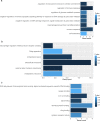Integrative analysis of key candidate genes and signaling pathways in autoimmune thyroid dysfunction related to anti-CTLA-4 therapy by bioinformatics
- PMID: 32500465
- PMCID: PMC7575511
- DOI: 10.1007/s10637-020-00952-z
Integrative analysis of key candidate genes and signaling pathways in autoimmune thyroid dysfunction related to anti-CTLA-4 therapy by bioinformatics
Abstract
Cytotoxic T lymphocyte-associated antigen-4 (CTLA-4), the first immune checkpoint to be targeted clinically, has provided an effective treatment option for various malignancies. However, the clinical advantages associated with CTLA-4 inhibitors can be offset by the potentially severe immune-related adverse events (IRAEs), including autoimmune thyroid dysfunction. To investigate the candidate genes and signaling pathways involving in autoimmune thyroid dysfunction related to anti-CTLA-4 therapy, integrated differentially expressed genes (DEGs) were extracted from the intersection of genes from Gene Expression Omnibus (GEO) datasets and text mining. The functional enrichment was performed by gene ontology (GO) annotation and Kyoto encyclopedia of genes and genomes (KEGG) pathway analysis. Protein-protein interaction (PPI) network, module enrichment, and hub gene identification were constructed and visualized by the online Search Tool for the Retrieval of Interacting Genes (STRING) and Cytoscape software. A total of 22 and 17 integrated human DEGs in hypothyroidism and hyperthyroidism group related to anti-CTLA-4 therapy were identified, respectively. Functional enrichment analysis revealed 24 GO terms and 1 KEGG pathways in the hypothyroid group and 21 GO terms and 2 KEGG pathways in the hyperthyroid group. After PPI network construction, the top five hub genes associated with hypothyroidism were extracted, including ALB, MAPK1, SPP1, PPARG, and MIF, whereas those associated with hyperthyroidism were ALB, FCGR2B, CD44, LCN2, and CD74. The identification of the candidate key genes and enriched signaling pathways provides potential biomarkers for autoimmune thyroid dysfunction related to anti-CTLA-4 therapy and might contribute to the future diagnosis and management of IRAEs for cancer patients.
Keywords: Autoimmune thyroid dysfunction; CTLA-4; Differentially expressed genes; Immune checkpoint blockade; Signaling pathway.
Conflict of interest statement
Ying Zhang declares that she has no conflict of interest. Francesca Garofano declares that she has no conflict of interest. Xiaolong Wu declares that he has no conflict of interest. Matthias Schmid declares that he has no conflict of interest. Peter Krawitz declares that he has no conflict of interest. Markus Essler declares that he has no conflict of interest. Ingo G.H. Schmidt-Wolf declares that he has no conflict of interest.
Figures







References
-
- Hammers HJ, Plimack ER, Infante JR, Rini BI, McDermott DF, Ernstoff M, Voss MH, Sharma P, Pal SK, Razak AR (2015) Expanded cohort results from CheckMate 016: a phase I study of nivolumab in combination with ipilimumab in metastatic renal cell carcinoma (mRCC). Am Soc Clin Oncol. 10.1200/jco.2015.33.15_suppl.4516
Publication types
MeSH terms
Substances
LinkOut - more resources
Full Text Sources
Medical
Research Materials
Miscellaneous

